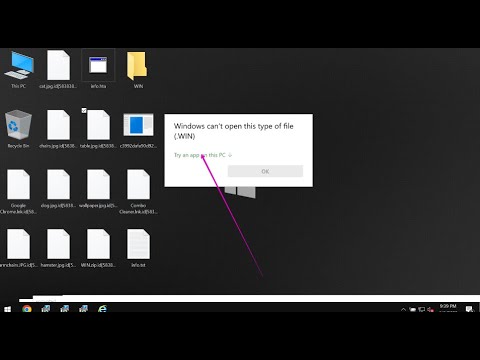You might have come across many different types of files on your computer. Some are familiar ones like .doc or .jpg, but others like .WIN might seem new and confusing.
Sometimes, this can lead to concerns like, “Is this file safe? Could this .WIN File a Virus be a virus?” This article will walk you through what .WIN files are. You’ll also learn whether they can be harmful and discover the right way to open them without worrying.
What is a .WIN file and its purpose?
A .win file is a file format used by various software programs on the Windows operating system. The ‘.win’ extension generally refers to a ‘Windows’ file and forms part of the broader file system used by Windows to manage information and processes.
These files serve various functions, often tied to the specific software program associated with them. For instance, some .win files store configuration or preference information, allowing the software to operate in a user-defined manner.
Other .win files may contain critical data necessary for the program’s functioning or even executable code run by the software.
How .win files operate in the Windows file system?
Within the Windows file system, .win files function as a set of instructions or data repositories that are read by their parent applications. Like other file types, they are automatically associated with specific software when that software is installed on a system.
In many cases, .win files are hidden from casual view, located in directories not frequently accessed by regular users. They typically operate in the background, silently contributing to the overall functioning of their related software.
However, it’s important to note that these files are common and often necessary for various applications but are not a standard part of the Windows system. Instead, they are more often introduced by third-party applications tailored for the Windows environment.
Is .win File a Virus?

A .win file is not inherently a virus or malicious. Typically, .win files are used by specific applications to store configuration data or game assets, among other uses.
However, like any other file type, .win files can also be exploited by malicious actors to spread malware or computer viruses.
How to Spot Malicious .win Files Instantly
- Source of the file: If you received the .win file from an unknown or untrusted source, especially if it’s an email attachment or downloaded from a sketchy website, you should be cautious.
- Unsolicited Download: It might be malicious if the .win file downloaded itself without your explicit action or permission.
- Irrelevant Context: If the .win file seems irrelevant in the context it’s presented in, for instance, receiving a .win file as an email attachment from a bank, it could be a sign of something malicious.
- Unexpected file format: If you were expecting a different file type (like a .doc or .pdf) but received a .win file instead, this might be a sign of a malicious file. Or suspicious files of any type. A simple virus scan or check could potentially save you from a lot of trouble down the road.
How to open a .win file on Windows 10 and Windows 11?
Opening a .win file is more or less the same process in Windows 10 and Windows 11. However, the specifics can depend on the software associated with the .win file.
Built-in methods to open .win files
- Double-click the .win file: If the .win file is associated with a particular application installed on your computer, double-clicking the file should automatically open it in that application.
- Open through an application: If the above step doesn’t work, you can try opening the application associated with the .win file first and then use its internal ‘Open’ or ‘Import’ command to open the .win file.
- Use ‘Open With’: If you can’t determine which program to open the .win file with, right-click the file, select ‘Open With,’ and then choose an application from the list.
How to use a .win file editor?
A .win file editor allows you to view and modify .win files—typically used by software developers or tech-savvy individuals who wish to alter the properties of a given software. Here is a step-by-step guide on how to use a .win file editor.
Note: Be very cautious when editing .win files, as improper changes can result in software malfunctions or even system instability. Always ensure to have a recent backup before proceeding.
- Obtain a .win file editor: Several .win file editors are available online, including ‘HxD Hex Editor’, ‘Free Hex Editor Neo’, and ‘010 Editor’. Download and install the editor that best suits your needs from a trusted source.
- Back up the .win file: Before you make any changes, ensure you have a backup of the .win file you are about to edit. This allows you to restore the original file if you make a mistake.
- Open the .win file: Launch the .win file editor application. Open the .win file you wish to edit usually by navigating to ‘File’, then ‘Open’, and selecting your target .win file.
- Edit the .win file: Modify the .win file’s content according to your needs. Ensure you understand what you’re changing and its impact on the associated software or system.
- Save the changes: After making your modifications, save the file. In most .win file editors, you can do this by going to ‘File’ and then clicking on ‘Save’.
- Test the changes: Finally, open the application related to the modified .win files to see if your changes have produced the desired effect.
How to handle .win files using Windows File Explorer?
Despite their unique extension, .win files are handled similarly to any other file in Windows File Explorer. Here’s a tutorial for the interaction of .win files with File Explorer:
- Navigate to the .win file: Using Windows File Explorer, locate the .win file you want to interact with by browsing its folder.
- Open the .win file: To open the file, double-click on it. The file should open automatically if an associated program is installed on your system.
- Rename the .win file: To rename the file, right-click on it and select ‘Rename.’ Type the new name and press ‘Enter.’ Be cautious while renaming the file, as this might cause issues with the associated application.
- Move or copy the .win file: To move or copy the file, you can either use the right-click context menu to access ‘Cut’ or ‘Copy’ or use the ‘Ctrl+X’ (for moving) and ‘Ctrl+C’ (for copying) keyboard shortcuts. Navigate to the destination folder and either right-click and select ‘Paste’ or use the ‘Ctrl+V’ keyboard shortcut.
- Delete the .win file: To delete it, right-click on it and select ‘Delete’ or use the ‘Delete’ key on your keyboard. The file will be moved to the Recycle Bin unless you use ‘Shift+Delete,’ which permanently removes it from your system.
Remember that improperly handling or modifying .win files can cause issues with their associated applications or, in some cases, system stability. Only interact with these files if necessary, and always back up important .win files before making any changes.
Conclusion
So, you see that .WIN files are just another type of file, like the others we use daily. They aren’t dangerous or harmful by themselves; what’s inside them can cause problems.
There are tools to open these files safely. But remember, always keep your computer’s antivirus up-to-date and be careful when dealing with unfamiliar files. This way, you keep your computer safe and sound.



